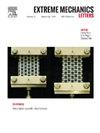Crystal size effect on large deformation mechanisms of thermoplastic polyurethane
IF 4.3
3区 工程技术
Q2 MATERIALS SCIENCE, MULTIDISCIPLINARY
引用次数: 0
Abstract
Thermoplastic polyurethane, a phase-separated polymer containing amorphous soft domains and crystal hard domains, is a widely used high-performance polymer. However, how the crystal size affects the mechanical properties of thermoplastic polyurethane remains unclear. In this work, molecular dynamics simulations are carried out to reveal the atomistic deformation mechanisms coupled to crystal sizes. The atomistic models contain finite crystal hard domains in a representative volume element with periodicity in three dimensions. With comprehensive analysis in tension, compression, and shear, we find that the crystal size affects the timing and difficulty of deconstruction and rotation in crystal hard domain, cavitation in amorphous soft domain, and therefore determine the structural strength at different deformation stages. For example, smaller crystal size renders higher yield strength yet lower ultimate tensile strength. The discovered crystal size effect allows us to envision a gradient nano-crystal thermoplastic polyurethane with its customizable yet exceptional mechanical properties. By engineering the spatial distribution of crystals with different sizes, the gradient nano-crystal thermoplastic polyurethane can be strong in tension, yet soft in compression. Our current work deepens the understanding of the deformation mechanisms of thermoplastic polyurethanes and provides insights into the rational design of block copolymer materials with desirable mechanical properties.
晶体尺寸对热塑性聚氨酯大变形机理的影响
热塑性聚氨酯是一种含有非晶软畴和结晶硬畴的相分离聚合物,是一种应用广泛的高性能聚合物。然而,晶体尺寸如何影响热塑性聚氨酯的机械性能仍不清楚。在这项工作中,进行了分子动力学模拟,以揭示与晶体尺寸耦合的原子变形机制。原子模型在具有三维周期性的代表性体元中包含有限晶体硬域。通过对拉伸、压缩和剪切的综合分析,我们发现晶体尺寸影响晶体硬畴的解构和旋转的时间和难度,以及非晶软畴的空化,从而决定了不同变形阶段的结构强度。例如,晶体尺寸越小,屈服强度越高,但抗拉强度越低。发现的晶体尺寸效应使我们能够设想一种梯度纳米晶体热塑性聚氨酯,它具有可定制的特殊机械性能。通过设计不同尺寸晶体的空间分布,可以使梯度纳米晶体热塑性聚氨酯具有强拉伸、软压缩的特性。我们目前的工作加深了对热塑性聚氨酯变形机制的理解,并为具有理想机械性能的嵌段共聚物材料的合理设计提供了见解。
本文章由计算机程序翻译,如有差异,请以英文原文为准。
求助全文
约1分钟内获得全文
求助全文
来源期刊

Extreme Mechanics Letters
Engineering-Mechanics of Materials
CiteScore
9.20
自引率
4.30%
发文量
179
审稿时长
45 days
期刊介绍:
Extreme Mechanics Letters (EML) enables rapid communication of research that highlights the role of mechanics in multi-disciplinary areas across materials science, physics, chemistry, biology, medicine and engineering. Emphasis is on the impact, depth and originality of new concepts, methods and observations at the forefront of applied sciences.
 求助内容:
求助内容: 应助结果提醒方式:
应助结果提醒方式:


